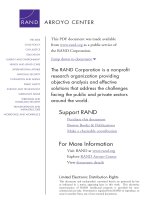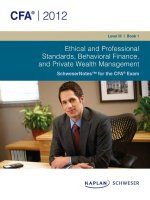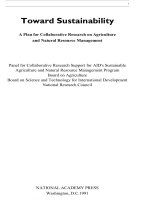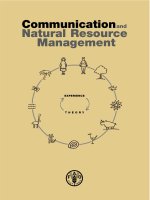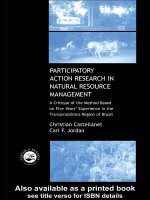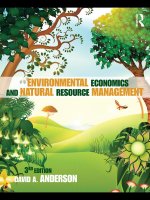Communication and Natural Resource Management pdf
Bạn đang xem bản rút gọn của tài liệu. Xem và tải ngay bản đầy đủ của tài liệu tại đây (131.2 KB, 23 trang )
EXPERIENCE
THEORY
Communicationand
Natural Resource
Management
Communication and Natural
Resource Management
Experience
Theory
Prepared by The Communication Initiative in collaboration with the
Communication for Development Group
Extension, Education and Communication Service
Research, Extension and Training Division
Sustainable Development Department
FOOD AND AGRICULTURE ORGANIZATION OF THE UNITED NATIONS
Rome 2003
All rights reserved. Reproduction and dissemination of material in this
information product for educational or other non-commercial purposes
are authorized without any prior written permission from the copyright
holders provided the source is fully acknowledged. Reproduction of
material in this information product for resale or other commercial
purposes is prohibited without written permission of the copyright
holders. Applications for such permission should be addressed to the
Chief, Publishing Management Service, Information Division, FAO,
Viale delle Terme di Caracalla, 00100 Rome, Italy or by e-mail to
© FAO 2003
The designations employed and the presentation of material
in this information product do not imply the expression of any
opinion whatsoever on the part of the Food and Agriculture
Organization of the United Nations concerning the legal or
development status of any country, territory, city or area or of
its authorities, or concerning the delimitation of its frontiers or
boundaries.
Table of Contents
Acknowledgement v
Foreword vii
About the Authors ix
Introduction 1
• Using This Book
• A World of Finite Resources
• Critical Perspectives
• Changing Approaches to Natural Resource Management
• Communication for Development and Social Change
• Insights and Direction
Experience 1
Community Based Natural Resource Management – Namibia 15
• Theme: Principles and Action
• Learning Objective: To improve participants’ understanding
of the relationship between differing communication principles
for effective change, and the planning and organisation of their actions.
Experience 2
Pastoralist Communication – Kenya 25
• Theme: Voices and Action
• Learning Objective: To advance participants’ understanding
of effective communication strategies, where substantive action is
sourced in the voice and perspective of the people most affected.
Experience 3
Indigenous Forest Management – Cambodia 33
• Theme: Issue Analysis for Action
• Learning Objective: To expand participants’ skills at analyzing
the issues to be addressed by the communication initiative.
Experience 4
Recovering From Conflict – Viet Nam 41
• Theme: Contextual Analysis for Action
iii
TABLE OF CONTENTS
• Learning Objective: To improve participants’ skills at analyzing
the contexts for change.
Experience 5
Internet Radio – Sri Lanka 49
• Theme: Culture and Action
• Learning Objective: To expand participants’ awareness
of the relationship between culture, context and strategy,
in developing effective communication initiatives.
Experience 6
Regional Networking – Costa Rica and Nicaragua 61
• Theme: Behavioural or Social Action
• Learning Objective: To develop participants’ ability to understand
the relation between individual behaviour change and
structural/social obstacles or supports to that change.
Experience 7
Creating Local Organic Markets – Turkey 71
• Theme: Education or Dialogue for Action
• Learning Objective: To improve participant’s ability to understand
key differences between approaches emphasising education
or dialogue and the programmatic implications of those emphases.
Experience 8
Environmental Education and Communication – El Salvador,
The Gambia, Jordan 77
• Theme: Innovation and Action
• Learning Objective: To heighten participants’ critical skills
at matching the requirements for action with the context for that action.
Drawing Your Own Conclusions 89
• Theme: Planning for Action
• Learning Objective: To prioritise the lessons of the previous
8 experiences and reflect on how they will impact on your own
future communication for development - natural resource
management work.
iv
COMMUNICATION AND NATURAL RESOURCES MANAGEMENT • EXPERIENCE/THEORY
v
ACKNOWLEDGEMENTS
Acknowledgements
FAO wishes to acknowledge the contribution of the Strategic Communication for
Sustainable Development Unit (DevCom-SDO) of the World Bank towards the produc-
tion of this book. DevCom-SDO is a technical group within the Communication for
Development Division whose goal is to introduce strategic communication as an inte-
grated component of policies and projects, and to ensure an efficient use of human
and financial resources. The Unit is also committed to the promotion of appropriate
communication concepts and tools and to capacity building initiatives in the field of
strategic communication for natural resource management.
For additional information please contact:
FAO: Senior Officer, Communication for Development Group, SDRE
www.fao.org/sd/kn1_en.htm
Communication Initiative: Chris Morry, Programme Director
World Bank: Lucia Grenna, Unit Head
DevCom – SDO –
Foreword
When FAO raised the idea of preparing a resource book in collaboration with The
Communication Initiative for people involved in communication and natural
resource management, it was clear that finding an approach that reflected the diver-
sity of thought, practice and local context would be a challenge. We hope that this doc-
ument meets that challenge by presenting experiences across cultural and theoretical
perspectives in such a way as to enable the reader to reflect on some of the shared
principles and lessons learned in this field.
For many years, under the definition of Communication for Development, FAO has
emphasized the critical role that participatory communication plays in involving com-
munities in rural development. Such a commitment to genuine participation requires
openness to the different ways of understanding and resolving problems that emerge
from the cultural, economic and agroecological realities of the communities involved.
During the past three decades the Communication for Development Group in the
Sustainable Department of FAO has integrated in several field projects the use of dif-
ferent communication approaches and media, and more recently new information and
communication technologies (ICTs), for community based rural development. These
experiences have shown that participatory communication processes can transform
the ability of rural stakeholders to fully manage local natural resources and to enable
community control over their environment.
The Communication Initiative has worked to increase the profile of communication
as a central element of successful development practise and to enable communication
practitioners to use peer review and real time information exchange to improve their
work. Through its ‘location’ as a crossroads for a range of information about, evalua-
tions on, and reviews of, communication projects, The Communication Initiative has
facilitated discussions across theoretical approaches, gathered information on grass-
roots initiatives from varied cultural and geographic settings and brought together prac-
titioners from very different backgrounds.
The two groups share an understanding of the centrality of communication for rural
development and social change, and a commitment to enhance rural people’s capac-
ities in managing communication processes. FAO is interested in exploring this in the
realm of natural resource management and rural development in order to strengthen
the work of communication practitioners. The Communication Initiative looks for ways
vii
FOREWORD
to profile and share the varied communication approaches and methods being used
successfully in the field. Both institutions want to facilitate a process of mutual learn-
ing among different stakeholders interested in sharing experiences about communica-
tion for natural resource management.
The result of this effort is a unique and not easily categorized resource book –
Communication and Natural Resource Management: experience/theory. It is not
a work of theory and yet examines theoretical perspectives. It is not an account of best
practises and yet provides examples of interesting and useful initiatives. It is not a train-
ing manual and yet presents exercises and learning objectives. It looks at how experi-
ence is, and can be guided by theory and how theory can be derived from under-
standing experience. It challenges us to reflect on our own and others’ work by treat-
ing theoretical approaches as interchangeable tools within a variety of different com-
munication and natural resource management initiatives. It encourages the readers to
learn from each other.
We hope you enjoy reading this book and find it a useful tool when thinking about com-
munication for natural resource management and rural development from perspectives
that shed new light on old problems.
Ester Zulberti Warren Feek
Chief Director
Extension, Education and The Communication Initiative
Communication Service, FAO
viii
COMMUNICATION AND NATURAL RESOURCES MANAGEMENT • EXPERIENCE/THEORY
About the authors
Warren Feek is Director of The Communication Initiative. He has also worked with
UNICEF as lead on Health and HIV/AIDS Communication in New York, with The
Commonwealth Secretariat as Director of Programmes related to young people, and
with a major New Zealand Non Governmental Organization. He is a New Zealander
living in Canada with his partner and 3 children.
Chris Morry is Programme Director of The Communication Initiative. He has also
worked for Oxfam Canada where he was the Country Representative in Namibia
responsible for programmes focused on NGO capacity building, agricultural develop-
ment and rural health care. He now lives in Canada with his family.
The writing and preparation of this book has been a collaborative effort from the begin-
ning. There are many people who helped us by allowing us to use their experiences
in the field, there are others who helped point us towards essential reading and docu-
mentation, still others read portions of the document for us and offered advice and use-
ful criticism. We thank all of you for helping make this a better book than it would have
been without you while exonerating all of you from any role in its failings.
At FAO we would particularly like to thank Loy Van Crowder and Mario Acunzo who
provided great support throughout the process and critical thinking when we needed
it. We would also like to thank Denise Gray-Felder, Brian Byrd and their colleagues at
the Rockefeller Foundation for their insight on social change in action, Adelaida Trujillo,
Raphael Obregon, and Alfonso Gumucio Dagron for reading and commenting on the
entire document. It is better for their input though they share no blame for its short
commings. Others who provided us with information and/or read and commented on
portions of the documents are Brian T. B. Jones, Kitty Warnock, Claire Thompson, Luz
Marina Rizo, Juan Carlos Cruz, Lyes Ferroukhi, and Victor Ananias. Thanks also to
the World Conservation Union (IUCN) who helped us locate some of the documents
used in the book and a special thanks to several people at Kothmale radio who pro-
vided us with important updated information on their work, to the team at GreenCOM
who provided significant and useful input, to Freedom Nyamubaya for writing and let
us use her poetry, and to all those of you whom we have not mentioned but probably
should have.
ix
ABOUT THE AUTHORS
Introduction
USING THIS BOOK
This book has been written as a tool for people involved or interested in communica-
tion and natural resource management who seek a better understanding of how dif-
ferent theories and strategic change principles relate to actual practise. It is not, how-
ever, a book of theory nor is it an argument for one approach over another. Instead, it
relates a variety of theories and change principles in simplified, almost schematic form,
to a series of real initiatives in the field through interactive «experiences».
It asks that the reader become a participant in a process that requires reading and
analysing each initiative using different theoretical lenses. Each «experience» is organ-
ised around a theme, a learning objective, a description of an actual natural resource
management and communication initiative, and one or two theoretical lenses through
which to analyse the initiative. As you work through each «experience», you will be asked
questions about the theory and change principles and how they relate to the initiative. The
idea is not to «discover» the right approach but rather to create an interactive space that
enables you to reflect on what might work in your own context and also on how different
contexts may require different approaches, principles and theoretical frameworks.
The reader will find no examples of «best practice» in this book nor will you find step-
by-step examples of how to «do» natural resource management communication.
While there are clearly examples of good practise and well planned initiatives in this
and other places
1
this is a book about exploring the practical relation between theory
and practise and about being open to different perspectives and approaches. Its for-
mat is designed for you to interact with directly. Spaces are there for you to write in,
make margin notes on, and highlight elements that are relevant to you. It is also
designed to be easy to photocopy so you can make multiple copies for yourself or oth-
ers. We encourage you to use it in workshops as well as a tool for individual reflection.
We hope you enjoy it and find it useful.
A WORLD OF FINITE RESOURCES
Between 1970 and 1999 the natural wealth of the earth’s forests, freshwater ecosystems,
oceans and coasts declined by 33 percent.
2
Today, 58 percent of the world’s coral reefs
1
INTRODUCTION
and 34 percent of all fish species are at risk.
3
Within the next 25 years 48 countries
accounting for 35 percent of the world’s projected population will face water shortages.
4
Over the next 50 years the world’s population is estimated to grow by 50 percent to 9.3
billion. Virtually all of this growth will be in today’s developing countries. The 49 poorest
countries will see their populations grow from 668 million to 1.86 billion people.
5
This grim statistical list could go on and on. The world has not managed its natural
resources well and the problem will almost certainly get worse before it gets better.
Furthermore, though the poorest and most marginalised have the smallest «footprints»
when it comes to using the world’s resources, they are also those who are and will be
effected first and worst. Therefore, while long term solutions to the world’s major envi-
ronmental and food security problems depend significantly on action from the wealthy
and most industrialised countries (those with the largest «footprints»), day to day sur-
vival for the poor and marginalised will depend increasingly on the careful local man-
agement of natural resources in a context of increasing scarcity and demand. Add to
this the impact of AIDS which has already killed an estimated 7 million agricultural
workers and is predicted to kill another 16 million by 2020
6
and it is clear that the com-
ing years will present unprecedented challenges especially for the rural poor.
So, as journeys to find firewood get longer, maintaining the fertility of the soil gets hard-
er, catches of fish get smaller, and the hands to do the work get fewer, the need to
effectively manage natural resources has never been greater. Similarly, improving
communication as a tool to facilitate the better management of limited resources has
never been more critical. But, finding ways to sustainably and equitably steward and
share these resources will require dialogue and compromise at global, national and
local levels. Future benefits need to be weighed against immediate costs, and short-
term interests against long term sustainability.
This exploration of experiences, theories and methods, will provide opportunities to
reflect on the critical role that communication for development can play in supporting
essential processes of dialogue. We hope that it offers some insight into how best to
support the many actions that people are already taking, as they confront the chal-
lenges facing us all in a world of finite natural resources.
CRITICAL PERSPECTIVES
Let us begin by drawing out some key themes through the voices of a Zimbabwean
war veteran, development worker and poet, and some leading thinkers in the areas of
2
COMMUNICATION AND NATURAL RESOURCES MANAGEMENT • EXPERIENCE/THEORY
Natural Resource Management (NRM) and communication for social change. In Dusk
of Dawn, a book of prose and poetry, Freedom Nyambaya writes:
A Career for Life
I am a retired soldier
not a retired revolutionary
I still walk around armed
with tools and ideas of how to grow more maize
There are still those of us
who consciously organise and create
Africa’s man-made problems and make
our suffering a career for interested scholars
7
From Grazia Borrini-Feyerabend, M.Taghi Farvar, Jean Claude Nguinguiri and Vincent
Awa Ndangang, in the Co-management of Natural Resources: Organizing, Negotiating
and Learning-by-Doing:
«In the past, many traditional societies formed relatively closed systems in which nat-
ural resources were managed through complex interplays of reciprocities and solidar-
ities. Communal property was generally widespread, and constituted a crucial element
in the cohesion and sustainability of traditional resource management systems. Local
knowledge and skills, built through extended historical experience, were another cor-
nerstone. Most importantly, local communities tended to create themselves around a
body of natural resources that they could manage together….
The historical emergence of colonial powers and nation states, and their violent
assumption of authority over most common lands and natural resources led to the
demise of traditional resource management systems virtually everywhere. The mon-
etisation of economic exchange weakened local systems of reciprocity and solidarity,
as did the incorporation of local economies into increasingly global systems of refer-
ence. In addition, the rise in power of modern, expert-based, «scientific» practices
induced severe losses in local knowledge and skills. This generalised breakdown of
local NRM systems finally resulted in the disempowerment and «deresponsibilisation»
of local communities
8
And again from Freedom Nyamubaya:
Shanty town beauty
She stood at the door step
3
INTRODUCTION
must have been five years or less
the begging eyes gazed from left to right
The kwashiokored tummy bulged out
of the torn dress
with marks that looked like the map of Africa
I realised it was not tattoo
but an accumulation of dust
run over by sweat
Pretty more than famous Cleopatra
everything equal
the girl would pass for Miss Africa
just another woman nature produced
but forgot to breast-feed
9
These two voices, while coming from radically different backgrounds, present us with
quite similar perspectives on the disempowerment of local communities, the impor-
tance of who «owns» development processes, and a sense of the mistrust and obsta-
cles to communication that have been created by colonialism, modernisation and glob-
alisation.
Grazia Borrini-Feyerabend et al. tell us of a series of external impositions on local com-
munities through colonial or state rule, the discounting of local knowledge in favour of
«scientific» knowledge, and in some cases the stripping away of local control in a
process they call «deresponsibilisation». These forms of disempowerment stripped
many local communities of the capacity and even the right to manage the resources
that had previously been the foundation of their existence and identity.
At the same time, and not surprisingly, these disempowering processes have generat-
ed mistrust and resistance. Freedom’s revolutionary commitment to the development
of tools and ideas to «grow more maize» and refusal to be objectified by scholars or
images of hunger and poverty, speaks to community frustration and anger, but more
importantly, to community strength and determination to reclaim what has been taken
away.
What they both say is that managing natural resources in the difficult times ahead will
require a clear recognition of the mistakes and abuses of the past. The «local» has to
have an influential, indeed powerful, seat at the NRM table, and previous patterns of
exclusion should be seen as having often been disastrous, both for local communities
and for the world as a whole.
4
COMMUNICATION AND NATURAL RESOURCES MANAGEMENT • EXPERIENCE/THEORY
CHANGING APPROACHES TO NATURAL RESOURCE
MANAGEMENT
Responses to the realities reflected above are not new to NRM or community-based
development. There have been significant changes to the methods and theoretical
underpinnings of all kinds of community development over the past 30 or so years.
Much of this change is the result of reflection on experience, coupled with, and some-
times forced by, the insistence of local voices like Freedom’s, to be heard and reckoned
with.
During the 1970s, practitioners working with rural communities began to be disillu-
sioned with the lack of progress, the failure of many development activities, and all too
often, worsening conditions for the poor. It can be assumed that the communities
themselves were even more disillusioned though their voices were seldom heard.
Early work on NRM focussed on the lack of local knowledge and the need to improve
this through education, training and outside expert advice. Local practices were sur-
veyed to identify what had to change, but not surveyed for the local wealth of experi-
ence and knowledge.
To the extent that this amounted to a communication method, it was one in which local
people were questioned to discover gaps in their knowledge that could be filled by
expert outsiders. Knowledge was usually seen as technical, value neutral, and trans-
ferable across cultures and continents. If not quite a one-size-fits-all approach, it was
based more on a belief in the universal application of methods defined by agricultural
science than «less rigorous» approaches that emphasised the centrality of social and
cultural practise.
As it became clear that this approach was not delivering the progressive improvements
it promised, two key problems were identified. The first was lack of local support for
many of the activities and projects designed by outsiders – Freedom’s «interested
scholars» or the «modern experts» of Borrini-Feyerabend et al. The second was fail-
ure due to poor understanding by outsiders of local social and environmental condi-
tions, made worse by not acknowledging the value of local experience.
Identifying these problems led to new approaches to communicating with rural peo-
ple that sought a better understanding of their local situation, and involved them in
identifying the issues that affected them most directly. This led to the adoption of
techniques such as «Rapid Rural Appraisal» (RRA), which enabled development
workers and other outside «experts» to gather simple data quickly on issues iden-
5
INTRODUCTION
tified at the local level. It also allowed some participation of semi-literate and illit-
erate people.
While this was an improvement over the complex and specialised information gather-
ing of the past, it was still based on outsiders obtaining information, which was then
taken away for analysis and use in the preparation of development interventions. Local
opinions and ideas were gathered more effectively, but control and ownership
remained outside of the communities being «developed».
Nevertheless, techniques like RRA opened the door to involving communities further
– not just in data collection, but also in data analysis, problem identification and priori-
tisation, and eventually (though still not often enough) participation in defining, imple-
menting and evaluating development interventions.
This more inclusive approach became popularly known as Participatory Rural Appraisal
(PRA). The key insight of PRA was that both local communities and outside «experts»
had information and knowledge to share. It was assumed that outsiders knew relatively
little about local conditions, practices and resources, while community members often
lacked technical knowledge that would help them adapt to changing social, political and
natural environments. The important change was the identification of a two-way approach
to communication that respected the experience and knowledge of both «inside» and
«outside» participants, and gave the community a voice in setting development priorities.
PRA helped move the community back towards the centre of the development process
and sought to better understand and overcome the difficult and often contradictory
positions in which communities find themselves when facing issues of sustainable
resource use. But, as important as this process of enabling communities to take own-
ership of their own development was and is, it does not fully respond to the interde-
pendent context in which all development processes must work.
Consider the issues faced by communities in the relatively remote San Juan River Bi-
National Basin in Central America (see Experience # 6). These communities are in Costa
Rica and Nicaragua. The basin itself forms a natural ecological and social unit, and there
are many cultural links between its inhabitants on both sides of the border. The area is
also open to a variety of business activities, and depends on, or is affected significantly
by, decisions and policies made in the relatively distant capitals of the two countries.
No matter how participatory an approach may be within a local community, there are
many other factors that can impact the local management of resources. If business
6
COMMUNICATION AND NATURAL RESOURCES MANAGEMENT • EXPERIENCE/THEORY
regulations are lacking, then unscrupulous and unsustainable practices that generate
little local benefit and much long-term damage can – and in the case of the San Juan
Basin did – occur. If governments make policies that do not take local needs and con-
cerns into account – or do not make policies at all – then local involvement and com-
mitment to the management of resources will be weaker or impossible.
The proper management of an area like the San Juan Basin requires the coordinated
participation of at least two national governments, local government, business and
local communities. To do this requires more than a commitment to participation at the
community level through processes like PRA; it requires meaningful participation at
multiple levels and across divides of geography, culture, education levels, income and
often fundamental interests.
For participatory approaches to succeed in this wider context of interdependent
influences another facet is required - a way to bring the necessary groups into con-
versation with each other, and to enable the poorest and most marginalised to have
a powerful/influential voice. In other words, a communication strategy that goes
beyond the relationship between «outside» development experts and «inside» com-
munity members.
Communication strategies that go beyond the local community retain the insights pro-
vided by approaches like PRA, but insist that equal importance be given to communi-
cation strategies dealing with the external contexts in which communities must func-
tion. This has been recognised in approaches like Participatory Rural Communication
Appraisal
10
and Co-management
11
.
The Namibia experience with Community Based Natural Resource Management
(see Experience 1) provides a good example of the importance of this kind of
expanded communication strategy. Here processes of «internal» communication
work together with parallel but linked processes of «outside» communication to
build participation and trust between different communities, levels of government
and policy makers.
Internally, Namibian communities had to find ways to separate and manage cattle and
wildlife, to stop poaching (a major economic activity of many of their own members),
to establish new forums for local and regional decision-making, and to learn skills and
adopt practices to manage resources in new ways. But for these to be successful, dif-
ferent communities had to share access to resources, traditional leaders had to make
co-ordinated decisions and share power, government planners had to listen to rural
7
INTRODUCTION
communities, and national leaders had to incorporate local ideas and priorities into
national policies.
This situation is not unique. In fact it can be argued that most development activities
require changes at the individual and local level as well as between communities, pol-
icy makers and private interests. Such changes require communication strategies that
look «in» and «out» at the same time, and that may involve quite different approaches
in different spheres. Unfortunately, while the situation is not unique, it is still rare to find
development initiatives that incorporate such communication strategies.
COMMUNICATION FOR DEVELOPMENT AND SOCIAL
CHANGE
This recognition that «the local» is embedded in complex relationships with other
actors and forces, has led to a related set of discussions on the role of communication
in the context of globalisation and new technologies. The Rockefeller Foundation has
initiated one of the more interesting of these discussions by involving people and
organisations from around the world, in an exploration of how to increase the impact
of communication as a tool in development processes given «globalisation» and new
communication technologies.
12
The discussion began from the premise that:
«…developments – in communications technologies, in political and media systems,
and in emerging development problems – suggest a greatly enhanced, radically differ-
ent role for communication in development programming.»
13
Three broad traditional roles were identified as having formed the core elements of
communication programming in development thinking and practise:
The first was to, «inform and persuade people to adopt… behaviours and practices…
beneficial to them.»
14
There are many familiar examples of this in HIV/AIDS, immuni-
sation, health and sanitation, reforestation, family planning, and soil and pest man-
agement, to name a few.
The second was to «enhance the image and profile of organisations involved in devel-
opment.»
15
This has been an important aspect of generating legitimacy for – mostly
northern – organisations and raising funds.
8
COMMUNICATION AND NATURAL RESOURCES MANAGEMENT • EXPERIENCE/THEORY
The third was to «enable community consultation over specific initiatives.»
16
This can
be compared to Participatory Rural Appraisal discussed above, where the focus is
more on community participation and involvement in a particular intervention, than the
surrounding context of influencing issues and actors.
Each of the three traditional areas is important but not sufficient to respond to the
changing technological, political and economic context in which development occurs.
In order to be able to make change effectively «inside» a community, the surrounding
environment must also change, or at least be recognised and influenced.
This need to understand the surrounding context applies to communication theory and
method as much as it applies to the communities and people that communication ini-
tiatives seek to reach. In other words, communication thinking must also reflect on
itself and the environment it works in, and change its own behaviours and practices
accordingly. Within the discussion, some key contextual changes have been identified
which are significant enough to require reflection on communication theory and
method. These are the liberalisation and deregulation of the media, the emergence of
new technologies, and a new global and political environment.
Media Liberalisation
Media liberalisation has broken the hold of many government-run and dominated infor-
mation services, which have been the source of information for much of the world’s
population. The general trend since the end of the Cold War has been for governments
to relax controls and enact freedom of speech laws.
The impetus has come from a variety of sources, both within countries and interna-
tionally, through political pressure from citizens groups and international donors, and
economic pressure, as new trade regimes demand the opening up of national media
to competition.
These trends present a double-edged sword. On the one hand, countries which had
heavily censored and controlled media, have seen the emergence of often vibrant and
populist newspaper, radio and television outlets, while old government-controlled insti-
tutions have faded due to falling audiences and funding.
On the other hand, the door has been opened to unregulated media that can further
disempower the marginalised. Government self-congratulation and disinformation has
often been replaced with a diet of Western pop music, and irrelevant or inaccurate
news.
9
INTRODUCTION
This trend has created a new communication environment in which single media out-
lets have been replaced with many, in highly-fragmented markets with multiple audi-
ences. Getting the message out now requires paying attention to more outlets and
audience segments, and the additional problem of encouraging the new media to play
a role in development processes.
We can see some of this in the GreenCOM experience in El Salvador (see Experience
# 8), where training reporters to better understand environmental issues, was consid-
ered central to building greater awareness and commitment to environmental sustain-
ability. It is also reflected in the Kenyan Pastoralist experience (see Experience # 2),
where reporters were sensitised to the culture and lives of pastoralists, and encour-
aged to write stories about them, to help build understanding for their issues, and
reduce their marginalisation within Kenyan society.
New Technologies
The revolution in information and communication technologies is profound. The
Internet, e-mail, mobile phones, satellite and wireless, have all opened up communi-
cations in ways not thought possible even a few years ago. Countries with collapsing
telecommunications infrastructures can utilise cell phones, microwave and satellite
technologies, to upgrade and more affordably replace old systems, and provide phone
and Internet service to isolated rural areas.
These systems are helping to connect previously isolated people to information and
other communities. The Kothmale project in Sri Lanka (see Experience # 5), demon-
strates how community radio can be linked to the Internet, to provide access to infor-
mation on health and agriculture. Other initiatives in Kothmale show how connec-
tions are being made with surrounding villages and ethnic groups, creating the
potential for greater understanding and dialogue between people isolated by terrain
and culture.
However, as the FAO has pointed out, «a combination of inadequate national commu-
nications policies; insufficient infrastructure, connectivity access and high costs; a
scarcity of skilled ICT labour; and a lack of local content creation and applications (lan-
guage and software) hinder ICT appropriation by poor nations and by poor regions
within nations and especially by isolated rural communities»
17
.
This «digital divide» could grow and serve to further widen the gap between rich and
poor, the connected and the marginalised. Furthermore, increasing access to new
technologies is only part of a response to ICT marginalisation. As Alfonso Gumucio
10
COMMUNICATION AND NATURAL RESOURCES MANAGEMENT • EXPERIENCE/THEORY
Dagron reminds us, «when we talk about technology we are only referring to instru-
ments, not to social, economic or cultural development. A knife is just a knife; it can
be used to hurt someone or to carve a beautiful wood sculpture. Content and utilisa-
tion is what makes the difference.»
18
There is great potential in many of the new technologies, but like media deregula-
tion, they are not in themselves good. The Internet for example, makes both amaz-
ing and terrible things possible. Its very openness means that it is used for both our
brightest and darkest dreams. It can be a place for tackling discrimination and
injustice head on, and it can be a place for the worst kinds of racism and exploita-
tion. It is also an instrument that is denied to many because of income, gender,
education, language and geographic barriers. Consider this set of UNDP statistics
from 1999:
• The typical Internet user worldwide is male, under 35 years old, with a university
education and high income, urban based and English speaking.
• A computer costs the average Bangladeshi more than eight years’ income, com-
pared with one month’s wage for the average American.
• English is used in almost 80 percent of websites. Yet fewer than one in ten peo-
ple worldwide speak the language.»
19
Others feel much more positive about the impact of the Internet and information com-
munication technologies (ICTs). For example, John Lawrence points out how:
«…in 1995, the Social Summit and the Beijing Fourth World Conference on Women
both engaged local communities in dialogue on crucial policy issues for the first time
via Internet (See Gurstein M. Community Informatics. Idea Publishing, Hershey
Pennsylvania 2000). The wealth of documentation on ICTs in the service of social
development and anti-poverty strategies following the Social Summit demonstrates
serious, local commitment by communities throughout the world. An important index
of the empowering potential of the Internet is the degree of resistance encountered in
autocratic societies. Also we should note the extraordinary contribution of the Internet
to reversing the «diaspora» effect in remoter, poorer or troubled regions (e.g. the 3
Pomegranate Network in Armenia ).
20
A recent study by the FAO’s Communication for Development Group on local appro-
priation of ICT’s found that:
On the one hand:
• there are a limited number of community driven ICT initiatives,
11
INTRODUCTION
• there is scarce visibility and coverage of grassroots driven ICT projects,
• most of the documentation on community ICT projects is relatively new because
the projects are new and few evaluations have been undertaken,
• the emphasis of ICT projects is more often on providing access to information than
on finding innovative ways to apply ICT’s to specific local needs,
• and the priorities of many ICT projects are influenced more by interests of exter-
nal organisations than local community based organisations.
While on the other hand ICT’s can:
• offer opportunities for two-way and horizontal communication,
• support bottom-up articulation of development needs,
• support, create and strengthen interactive and collaborative networks,
• support policy and advocacy,
• help build consensus,
• and enhance partnership with the media.
21
Whether sceptical or optimistic about the potential of these new technologies to spark
serious social change that benefits the poor and empowers the marginalised, there is
recognition that they can offer cheaper and more accessible communications, and pro-
vide increased opportunities for horizontal (as opposed to hierarchical) forms of dia-
logue and information sharing.
It is still too early to pass judgement on the potential of these technologies, but if the
central questions about «content» and «utilisation» are to be confronted, who better to
do so than those concerned with communication for social change?
Politics and Economy
The final set of trends identified through the Rockefeller discussion, concern changes
to the political and economic environment. One aspect of this has been the end of the
Cold War, and with it the emergence of more open political systems. Even states that
retain one-party systems or function as monarchies or theocracies are more open to
political debate and to greater freedom of expression.
This has been reinforced by the emergence of a global economy in which, «for the first
time in human history the entire planet is capitalist, since even the few remaining com-
mand economies are surviving or developing through their linkages to global, capital-
ist markets.»
22
This enclosure of the world within a single economic system is requir-
ing all governments to make adjustments, and one aspect of this process is to make
information more available. The global marketplace has helped create some of the
12
COMMUNICATION AND NATURAL RESOURCES MANAGEMENT • EXPERIENCE/THEORY
impetus for government to deregulate media and relax freedom of speech laws. This
has been reinforced by the Internet, which has proven very difficult for even the most
authoritarian governments to regulate.
23
However, the globalisation of the capitalist system has also led to an increasing con-
centration of ownership in the communication field. For example, AOL/Time Warner
controls 32 percent of the US Internet service provider market
24
. This concentration of
ownership is compounded by the convergence of media and telecommunication indus-
tries in which a few very large multinational companies now control both transmission
systems and the programmes they carry. There are clear trends towards concentra-
tion and centralisation on the one hand, and fragmentation, coupled with the potential
for networked or horizontal communication on the other. While it is not clear how these
seemingly contradictory tendencies will work themselves out, they require that anyone
involved in communication watch them closely as they are about who controls the flow
of world information.
INSIGHTS AND DIRECTION
Discussions and debates about what these changes to the communication environ-
ment mean range around a few key insights. For our purposes – examining what expe-
rience and theory have to show us about the use of communication in natural resource
management (NRM) – the most telling points are:
1. There is a complex history of unequal power relationships and economic mar-
ginalisation in which community level development processes are embedded
and from which lessons can be drawn and better approaches to communication
built.
2. Preferred methods and approaches to communication in NRM, have moved from
«expert» outside advice provided for «recipient» communities, to the sharing of
knowledge in a process of mutual exchange, where the community determines its
own development priorities.
3. Local communities do not exist in isolation from wider contexts of social, political,
economic and environmental forces, and these need to be taken into account.
4. Most NRM initiatives require communication strategies for both internal and exter-
nal processes.
5. New communication technologies have increased the possibilities for marginalised
communities to access information, and to have their voices heard from local to
global levels.
13
INTRODUCTION
6. The obstacles to this access remain and should not be underestimated, as they
are caused by language, gender, poverty, geography, discrimination, and a variety
of other forms of marginalisation and disempowerment.
7. There are many experiments in the use of communication and NRM, but these are
as recent as the new technology or method employed, and can only show us par-
tial glimpses of what is possible and what is sustainable.
8. For every positive indication of how ICTs may create opportunities for those
involved in communication for social development, there are negative aspects that
must be kept in mind such as the digital divide, the concentration of ownership
over the means of communication, and who controls the content and utilisation of
communication tools and approaches.
In spite of these potential pitfalls, many people, communities and organisations around
the world, have begun to experiment with a variety of approaches to communication
and NRM that make use of inclusive methods and technologies (some new and some
traditional).
It is easy to feel we are at a point where there are more questions than answers, and
more uncertainty than clear direction. However, there are opportunities and possibili-
ties being created by people wherever they are engaged and lessons being learned in
the process of engagement. If the paths we should follow are not clearly marked the
general direction has been mapped and to paraphrase the words of Spanish poet
Antonio Machado «Traveller! there are no paths, paths are made by walking»
(Cantares XXIX).We hope that you will find the following «experiences» useful as tools
to explore other contexts and theoretical perspectives while gaining insight into your
own communication practise.
14
COMMUNICATION AND NATURAL RESOURCES MANAGEMENT • EXPERIENCE/THEORY


